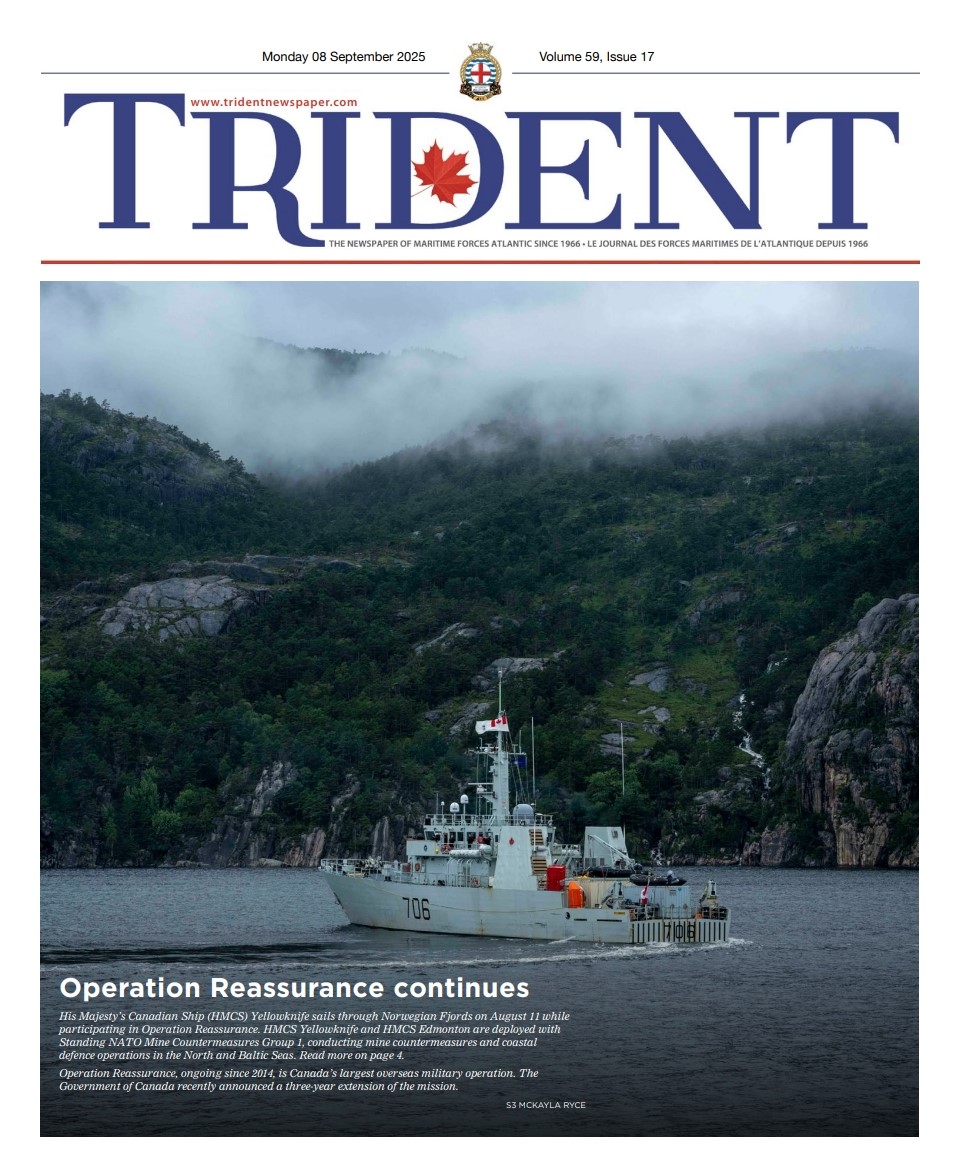Home
Frequently Asked Questions
What is the extent of the community consultations DND has undertaken? Will there be more community engagement?
DND is committed to being open, honest, and transparent in its communication with the community so the people of Eastern Passage understand what is being built and how it will affect them.
In March 2022, the first community engagement session took place with the public.
On October 28, 2022, a project update was provided on the Trident News website, which was followed by a mass mail out to the local community on November 4, 2022.
Between November 17 and 25, 2022, DND conducted introductory phone calls with local leaders representing community groups such as hiking, birding, environment, etc. In addition, in-person meetings with community groups were offered from December 12 to 16, 2022.
On December 22, 2022, a project update was provided on the Trident News website.
DND organized a second Community Engagement Session on January 31, 2023.
Project updates were posted on the Trident News website in February 2023, March 2023, April 2023, May 2023, September 2023 and February 2024, August 2024, and January 2025 and will continue to be provided on a regular basis.
Members of the public are always welcomed to contact DND’s LBTF project team to ask questions or provide comments by emailing CFBHalifaxPublicAffiars@forces.gc.ca.
Building Location
Why is this being built at Hartlen Point?
Land-Based Testing Facility site selection bulletin – click here.
Health and Safety of Emitters
Are there any potential risks to either human health or the environment from long-term operation of emitters at this facility?
The safety of the public, Defence Team personnel, and the environment is of significant importance. RF compliance requirements are rigorous and like any other project involving RF emitters (such as cell phone and radio towers or airport control towers), the LBTF must comply with Health Canada Safety Code 6 (Safety Code 6), which requires that there will not be adverse health effects from exposure to radiofrequency electromagnetic fields at the levels permitted by Safety Code 6.
As ship design progresses, further information on RF emissions will be available and once all required technical data is available, the RF notification and licensing processes can formally commence. The LBTF project is also awaiting completion of an Electromagnetic Environmental Effects (E3) analysis. An E3 analysis is conducted by highly specialized subject matter experts. The results of the analysis will inform considerations, mitigations, and operating procedures at the facility in compliance with Safety Code 6. The RF licensing effort must be completed before any antennae are operated. This activity is expected to be initiated in 2025 and completed in 2027.
A number of these types of facilities are operated by our Allies across the world, such as the Maritime Integration and Support Centre in Portsmouth, UK, and the Combat System Engineering Development Site in Moorestown, NJ USA.
Environmental Assessment
What environmental assessments have been done to date and have they been done by third party experts?
DND acknowledges and respects the thriving biodiversity and ecosystem at Hartlen Point.
On behalf of DND, third party, unbiased, experts have conducted a number of environmental studies over four seasons:
- Soil Characterization by SNC Lavalin (SNCL) – click here for the full-length report (English only).
- Wetland Assessment by Canadian British Consulting Limited (CBCL) – click here for the full-length report (English only).
- Bird and Bat Assessment by Canadian British Consulting Limited (CBCL) – click here for the full-length report (English only).
- Environment Effects Determination by Stantec – click here for the full-length report (English only).
- Soil Characterization Results and Soil Management Plan by Stantec – click here for full-length report (English only).
What do the environmental assessments account for and how is accountability ensured?
An Environmental Effects Determination (EED) report is an independent, third-party study. It examines potential impacts the project might have on the environment and the area impacted, as well as mitigation options. Following the EED report is standard across all DND infrastructure projects. While public input is not typically part of the EED report, all relevant regulatory bodies, including Environment and Climate Change Canada, are engaged to support meeting the required environmental legislation and regulations.
- The Environmental Effects Determination for the Land-Based Testing Facility project is now finalized and is available here.
DND is governed by the Impact Assessment Agency of Canada’s process, which dictates how the EED report is conducted. Additional information on the process is available here.
DND must also follow a variety of environmental legislation, policies, and guidelines. Those include:
Federal
- Impact Assessment Act
- Canadian Environmental Protection Act
- Fisheries Act
- Species At Risk Act
- Migratory Birds Convention Act
- Federal Sustainable Development Act
- Canada Labour Code (Part II – Occupational Health and Safety)
- CCME Environmental Quality Guidelines
- Federal Policy on Wetland Conservation
- Aboriginal Consultation and Accommodation: Updated Guidelines for Federal Officials to Fulfill the Legal Duty to Consult
Provincial/Municipal
- NS Environmental Protection Act
- NS Occupational Health and Safety Act
- NS Endangered Species Act
- Applicable Halifax Regional Municipality by-laws (i.e., N-200 Noise, S-600 Solid Waste Collection and Disposal, W-101 Wastewater Discharge)
- Guidelines for Disposal of Contaminated Solids in Landfills
- Ontario Ministry of Natural Resources and Forestry Survey Protocol for Species at Risk Bats within Treed Habitats (2017)
Department of National Defence (DND)
- DND Directive Regarding Environmental Impact Assessment (and Interim EIA Direction)
- DND Contaminated Sites Instruction CSI.004.001 Soil Management
- Aide-Memoire for DND Employees and CAF Members on the Common Law Duty to Consult with Indigenous Groups
- DND No Idling Policy
- Applicable MARLANT SEMS Directives (i.e., #E1 Spill Prevention and Reporting, #E2 Contaminated Sites Management, #E2 Annex A Protocol for Handling Impacted Soil)
- B-GL-381- 003/TS-000, Range and Unexploded Explosive Ordnance (UXO) Clearance Handbook
The EED report is completed in accordance with these regulations, as well as input provided via the Community Engagement Sessions that took place in March 2022 and January 2023, regulatory stakeholder engagement, and other stakeholder engagement. Other environmental baseline studies that were conducted by various consultants at the site including bird, wetland and vegetation surveys, feed into the EED report, along with preliminary engineering input. The EED report describes the project components and activities and assesses potential effects on physical, biological and socioeconomic components. Mitigation (e.g., best management practices, adherence to DND directives) are proposed to reduce potential adverse and residual effects.
DND is collaborating with governmental regulatory authorities, including but not limited to Environment and Climate Change Canada and the Department or Fisheries and Oceans. DND legally must comply with these regulatory authorities.
Update – January 2025: DND has been examining the possible issue of coastal erosion and the need for shoreline stability since the original EED for the LBTF project was completed. Before a detailed design for shoreline stability can be completed, an additional EED must be prepared. As part of this process, DND will be inviting the public to provide comments on the Canadian Impact Assessment Registry (CIAR) website. The posting will go live during the week of January 13-17, 2025, and will be open for public comment for 30 days.
Is there any consideration for permanent protections for habitat and staging areas at Hartlen Point?
A decision on permanent protections is outside the mandate of DND and the LBTF infrastructure project. While there is presently no intention for permanent protections for habitat and staging areas at Hartlen Point, there are numerous existing environmental policies, plans and programs already established and managed by the Maritime Forces Atlantic and Canadian Forces Base Halifax Safety and Environment teams. These guide positive environmental stewardship and protect species at risk on Defence property in the Halifax region, including Hartlen Point. There is a Natural Resource Management Plan (NRMP) for Hartlen Point which instructs the stewardship of ecological resources to be consistent with federal direction. It includes natural resource inventory information for species at risk, migratory/breeding birds, wetlands, aquatic habitat, integrated pest management and forests. The NRMP provides strategies for the maintenance or enhancement of biodiversity through identification of sensitive habitats so that DND activities do not have an adverse effect on local flora and fauna.
Traffic Assessment
Will construction and operations of the building increase traffic risks where it becomes a concern to residents and the public?
DND recognizes there are concerns about increased traffic in the region and these are taken seriously.
As part of this project, DND conducted a traffic study to determine the potential impacts on traffic in the area during construction, as well as when the facility is operational. The summary of results from the draft report was shared publicly at the January 31, 2023 Community Engagement Session.
The Traffic Impact Statement for the LBTF project is now finalized and is available here.
Near-shore and Coastal Access
Will construction or operation of this facility impact near-shore or coastal access?
Once the construction of the facility begins, access to the immediate area around the facility will be restricted for operational security and public safety reasons. This could potentially include areas up to the water’s edge but is not expected to affect areas in the water. The details of what those security measures will include are still being determined.
Once operational, there may be limited access during brief operational periods. DND is also making every effort so that there is no need for a permanent exclusion zone at Hartlen Point once the facility is operational.
Schedule
Why is the construction delayed now from March 2024 to summer 2025?
The building design is being done in parallel with ship design, meaning that the facility’s design progress relies on detailed specifications of various ship requirements. This iterative design process has impacted the LBTF design and construction milestones. To maintain project timelines while the facility design progresses, site preparation work has been initiated and continues to be advanced at Hartlen Point. This work includes brush clearing, installation of a new access road, extension of municipal services, laying gravel and installing culverts. Additional on-site activities expected to be completed by summer 2025 include include construction of a water meter building and excavating and backfilling, footings and foundations and potentially structural steel. Full construction of the facility is expected to begin in summer 2025 and finish in 2027. This is an intentionally flexible and risk-based approach for successful and timely delivery of this complex project.
Security
Why is there a 24/7 security presence at the site at the time of early site preparation and construction?
DND, in coordination with its contractors, is committed to providing a safe and secure work site for the safety and protection of both its workers and the public. Security presence is required for access control to the site in accordance with security and health and safety parameters.
What are the significant differences between Hartlen Point Land-Based Testing Facility (LBTF) and Seaspan Shipyard in the Port of Vancouver, which is being built directly across the Harbor from downtown Vancouver?
The Hartlen Point LBTF and Seaspan Shipyard Land-Based Test Site are completely different in scope, size, and complexity, and each project serves a different purpose.
The Hartlen Point LBTF project will deliver a new, purpose-built testing facility for the design, integration, testing, evaluation, and accreditation of equipment for new Canadian Surface Combatant ships and regular upgrades throughout these ships’ lifecycle. This facility will be used to test and integrate the ships’ capabilities, including electronic, radio and radar systems, before being installed on actual vessels. There are no existing facilities in Canada that provide this specific capability.
The Seaspan Shipyard provides shipyard services including new construction, maintenance, and repair. Although the Seaspan shipyard is incorporating a Land-Based Test Site, the ship components they are testing there are for the Canadian Coast Guard, which are completely different vessels with different testing and integration requirements. This facility and its site location are unable to support Canadian Surface Combatant requirements.
Contact Us
Email us about the project and subscribe to our email list to receive updates about the project at: CFBHalifaxPublicAffairs@forces.gc.ca





